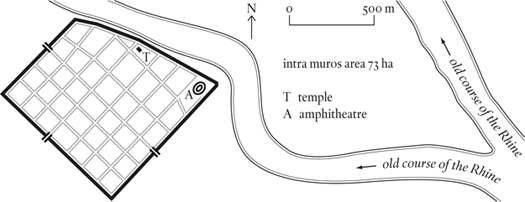
North Rhine-Westphalia, Germany
Classical Colonia Ulpia Traiana
In the Gallo-German revolt of AD 69–70, the rebels conquered and destroyed a Roman camp (Vetera I) that had been founded near the west bank of the lower Rhine by Augustus. The military camp was later reconstructed at a site closer to the Rhine (Vetera II), opposite its confluence with the River Lippe. This second legionary fort remained occupied until at least around AD 260 as part of the province of Germania Inferior.
Near the fort, Tiberius had resettled the German tribe of Sugambri from their former home on the opposite (east) bank of the Rhine. Under the emperor Trajan (Marcus Ulpius Traianus) and in around AD 100, this settlement was raised to the status of a colony under the name Colonia Ulpia Trajana. From that time, the Roman fort was occupied by the legion XXX Ulpia Victrix. The colony seems to have enclosed an area of around seventy-three hectares. It was laid out in the traditional Roman grid of streets running nearly at right angles to each other, and was surrounded by a wall with eight gates. Because there was little rock in the area, the walls were built with stone hauled by cargo ships from the ‘Seven Peaks’ up the Rhine near Bonn.

Systematic excavations began in 1972. They have revealed two temples, a large bath complex, a wrestling school and an amphitheatre. The latter building would have held around 12,000 spectators. Water came from a spring lying eight kilometres (five miles) to the west, and the major streets varied in width from eleven to sixteen metres. It has been estimated that the colony’s inhabitants numbered between 10,000 and 40,000 persons, with the most probable figure being in the lower half of that range.
The modern name Xanten derives from ‘ad Sanctos’ (‘to the saints or martyrs’), the name of a monastery founded in around AD 590. The site became a pilgrimage destination during the Middle Ages due to its association with the death of Viktor, a Roman saint killed during a persecution under the emperor Julian II (AD 362–3).